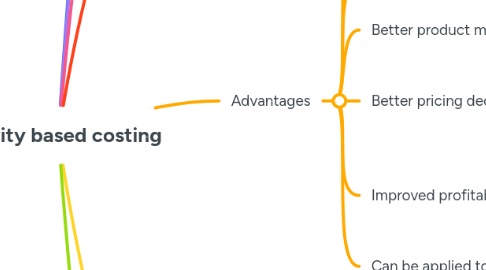
1. An alternative costing method
2. Overheads and indirct costs allocated based on specific activities
3. Processes
3.1. Identifying cost pools
3.1.1. This is the amount of money spent on specific activities, such as support functions and activities rather than production volumes
3.1.2. Such as technical and mechanical assembling, such as painting cars etc
3.2. Identifying cost drivers
3.2.1. What cause costs in the cost pool to be incurred
3.2.2. Example, laser-cutting cost pool would increase with every additional machine set-up
3.3. Finding cost driver rate
3.4. Allocate OH to the cost items
3.4.1. Multiply CDR with the cost driver quantity
4. Levels of costs
4.1. Unit-level costs
4.1.1. Such as direct costs such as raw material
4.1.2. Similar to traditional costly -> Directly
4.2. Product-level costs
4.3. Batch-level costs
4.4. Facility-level costs
4.4.1. Such as rent, security and depreciation
5. Advantages
5.1. Accurate absorption of OH
5.2. Cost control
5.2.1. Any inefficiencies can be identified and traced back to the cost drivers
5.3. Better product mix
5.4. Better pricing decision
5.4.1. If our COS is growing at a higher rate than our revenue, this could mean that our products cost us too much or we are not selling them for enough
5.4.2. ABC can help us identify how much it costs to produce our products and help price pur products accurately
5.5. Improved profitability analysis
5.5.1. The fixed costs are allocated accordingly
5.5.2. Profit margins calculated for each product range lead to improved profitability analysis of our products, our customers and our overall operation. This allows us to make effective decisions to improve our overall profitability.
5.6. Can be applied to all overhead costs not just production overheads
6. Disadvantages
6.1. Not suitable where there is long continuous production
6.1.1. Or if a single product is produced
6.1.2. Or where high level of manual work is involved; majority of costs would include labor costs and overheads lower
6.1.3. Or if the products go through a simple or similar production process
6.2. Costly
6.2.1. If benefits outweigh costs
6.2.2. Or we cannot fully interpret the information the system will provide
6.3. Not required by IAS 2
6.3.1. IAS 2 only requires an 'appropriate' amount of absorption of fixed overheads
6.3.2. ABC fulfills this requirement, but such a comprehensive approach is unnecessary, at least for financial reporting puposes
